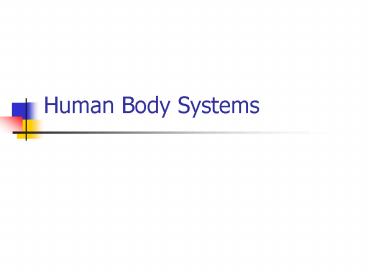Human Body Systems - PowerPoint PPT Presentation
1 / 29
Title: Human Body Systems
1
Human Body Systems
2
Organization of The Body
- The eleven organ systems of the human body work
together to maintain homeostasis - Homeostasis process which organisms maintain a
relatively stable internal environment
3
Human Organ Systems
Figure 35-2 Human Organ Systems Part I
Section 35-1
Nervous System
Integumentary System
Skeletal System
Muscular System
Circulatory System
4
Figure 35-2 Human Organ Systems Part I
Section 35-1
Nervous System
Integumentary System
Skeletal System
Muscular System
Circulatory System
5
Figure 35-2 Human Organ Systems Part I
Section 35-1
Nervous System
Integumentary System
Skeletal System
Muscular System
Circulatory System
6
Figure 35-2 Human Organ Systems Part I
Section 35-1
Nervous System
Integumentary System
Skeletal System
Muscular System
Circulatory System
7
Figure 35-2 Human Organ Systems Part I
Section 35-1
Nervous System
Integumentary System
Skeletal System
Muscular System
Circulatory System
8
Figure 35-2 Human Organ Systems Part 2
Section 35-1
Respiratory System
Digestive System
Excretory System
Endocrine System
Reproductive System
Lymphatic System
9
Nervous System
- Brain, Spinal cord, periperal nerves
- Function Coordinates the bodys response to
changes in its internal and external environments
10
Nervous System
Figure 35-2 Human Organ Systems Part I
Section 35-1
Nervous System
Integumentary System
Skeletal System
Muscular System
Circulatory System
11
Integumentary System
- Skin, hair, nails, sweat and oil glands
- Function Serves as a barrier against infection
and injury helps to regulate body temperature
provides protection against ultraviolet radiation
from the sun
12
Figure 35-2 Human Organ Systems Part I
Section 35-1
Nervous System
Integumentary System
Skeletal System
Muscular System
Circulatory System
13
Respiratory System
- Nose, pharynx, larynx, trachea, bronchi,
bronchiales, lungs - Function Provides oxygen needed for cellular
respiration and remove excess carbon dioxide from
the body
14
Figure 35-2 Human Organ Systems Part 2
Section 35-1
Respiratory System
Digestive System
Excretory System
Endocrine System
Reproductive System
Lymphatic System
15
Digestive System
- Mouth, pharynx, esophagus, stomach, small and
large intestine - Function Converts foods into simpler molecules
that can be used by the cells of the body
absorbs food
16
Figure 35-2 Human Organ Systems Part 2
Section 35-1
Respiratory System
Digestive System
Excretory System
Endocrine System
Reproductive System
Lymphatic System
17
Excretory System
- Skin, lungs, kidneys, ureters, urinary bladder,
urethra - Function Eliminates waste products of metabolism
from the body maintains homeostasis
18
Figure 35-2 Human Organ Systems Part 2
Section 35-1
Respiratory System
Digestive System
Excretory System
Endocrine System
Reproductive System
Lymphatic System
19
Skeletal System
- Bones, cartilage, ligaments, tendons
- Function Supports the body protects internal
organs allows movement stores mineral reserves
provides a site for blood cell formation
20
Figure 35-2 Human Organ Systems Part I
Section 35-1
Nervous System
Integumentary System
Skeletal System
Muscular System
Circulatory System
21
Muscular System
- Skeletal muscle, smooth muscle, cardiac muscle
- Function Works with skeletal system to produce
voluntary movement helps to circulate blood and
move food through the digestive system
22
Figure 35-2 Human Organ Systems Part I
Section 35-1
Nervous System
Integumentary System
Skeletal System
Muscular System
Circulatory System
23
Circulatory System
- Heart, Blood vessels, blood
- Function Brings oxygen, nutrients, and hormones
to cells fights infection regulates body
temperature
24
Figure 35-2 Human Organ Systems Part I
Section 35-1
Nervous System
Integumentary System
Skeletal System
Muscular System
Circulatory System
25
Endocrine System
- Hypothalamus, pituitary, thyroid, parathyroids,
adrenals, pancreas, ovaries(in females), testes
(in males) - Function Controls growth, development,
metabolism, and reproduction
26
Figure 35-2 Human Organ Systems Part 2
Section 35-1
Respiratory System
Digestive System
Excretory System
Endocrine System
Reproductive System
Lymphatic System
27
Reproductive System
- Testes, epididymis, vas deferens, urethra, and
penis (in males) Ovaries, fallopian tubes,
uterus, vagina (in females). - Produces reproductive cells in females, nurtures
and protects developing embryo
28
Figure 35-2 Human Organ Systems Part 2
Section 35-1
Respiratory System
Digestive System
Excretory System
Endocrine System
Reproductive System
Lymphatic System
29
Lymphatic System
- White blood cells, thymus, spleen, lymph nodes,
lymph vessels - Helps protect the body from disease collects
fluid lost from blood vessels and returns the
fluid to the circulatory system.































